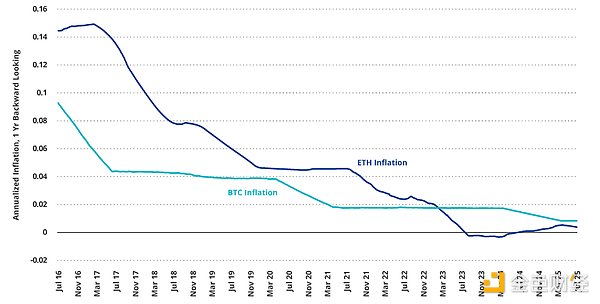Written by: VanEck
Translated by: AIMan@Golden Finance
The digital asset treasury is rapidly evolving, with the most common choices being BTC and ETH. Initially, entities chose BTC for its strong value storage properties created by its monetary policy. The key to this policy structure is the predictable issuance of BTC, which leads to a limited total supply of BTC. Recently, DATs (Digital Asset Treasuries) focused on Ethereum have emerged. These new DATs consider ETH to be a better choice for operating a digital asset treasury, as savvy companies can engage in some novel financial activities to accumulate ETH at a faster rate than BTC.
BTC treasuries can increase their holdings of BTC by financing additional purchases, implementing complex options strategies, or lending out BTC, while ETH treasuries have greater flexibility. ETH DATs can replicate the financial strategies of BTC DATs and stake their ETH to earn rewards from the Ethereum network and inflation issuance. Additionally, they can participate in DeFi for extra income. However, in discussions, the fundamental differences between Ethereum and Bitcoin are often overlooked. Ethereum may form an economic system that is more favorable to its token holders than BTC.
Ethereum will celebrate its 10th birthday on July 30, 2025. Ethereum's initial inflation rate was significantly higher than Bitcoin's, at 14.4% compared to 9.3%. However, Ethereum subsequently underwent two major economic policy adjustments that reduced its inflation rate below that of Bitcoin.
The first adjustment was EIP 1559, which was implemented in August 2021 and triggered the "burning" of the base transaction fees for ETH. The consequence of this change was that increased Ethereum activity led to a reduction in the total supply of ETH.
The second major policy change was Ethereum's transition from Proof of Work (PoW) to Proof of Stake (PoS). This transition, known as "The Merge," occurred in September 2022. The Merge reduced Ethereum's inflation issuance from about 13,000 ETH per day to approximately 1,700 ETH per day, as it no longer needed to compensate miners for maintaining its network.
As a result, since March 8, 2023, Ethereum's inflation rate has been lower than that of BTC. Since then, the supply of ETH has only increased by +0.2%, while the supply of BTC has grown by +3%. In fact, the combination of these two upgrades has temporarily reduced the supply of ETH.
From October 7, 2022, to April 4, 2024, the total supply of ETH decreased from about 120.6 million to approximately 120.1 million, achieving an annualized inflation rate of -0.25% during this period. Subsequently, due to improvements in Ethereum's transaction throughput (TPS), the amount of ETH burned decreased, and the Ethereum network accumulated an additional supply of +0.5%. Meanwhile, the supply of BTC increased by +1.1% during the same period.
Since March 8, 2023, the inflation rate of ETH has been lower than that of BTC.

Data source: Glassnode, as of July 31, 2025.
However, the superiority of ETH's inflation policy may not last long. Bitcoin's halving in April 2024 is expected to reduce its inflation rate by -50%. Currently, ETH's annual inflation rate over the past year is +0.38%, while BTC's inflation rate is +0.84%. In the upcoming halvings, BTC's inflation rate will approach +0%. In contrast, Ethereum's inflation rate is difficult to predict, potentially reaching +0.5% or even negative. Even if ETH's current inflation trajectory remains unchanged, BTC's inflation rate will not fall below that of ETH until 2028.
A severely underestimated dynamic is the issue of Bitcoin's security budget. Bitcoin maintains inflation issuance as an incentive for miners; without inflation issuance, it must rely on network transaction fees. Last year, miners profited $278 million from transaction fees and $14.64 billion from network inflation. Clearly, if miners are forced to rely solely on transaction fees, their economic situation would require a complete adjustment. As halvings occur, the price of BTC must rise to compensate for the reduced network inflation to maintain miners' economic viability. If this price trajectory does not materialize, network security may have to adopt a different economic model. There are many potential solutions to this issue, and any changes will not have a definitive impact on Bitcoin. However, adjustments to monetary policy will inevitably have winners and losers.
For example, one option to resolve the security budget dilemma is for Bitcoin to introduce inflation through a hard fork. Regardless of its specific implementation, it would weaken one of the core criticisms of Ethereum, which is that its economic policy is too flexible. More importantly, it would impose a tax on Bitcoin holders in favor of miners. These political economic decisions are not zero-sum games, and the miner-centric Bitcoin system tends to favor miners' interests over those of token holders. In a Proof of Stake (PoS) system like Ethereum, token ownership determines which fork validators will follow, as stakes will shift to validators who choose the preferred fork. In contrast, Bitcoin's fork selection rules are ultimately determined by the miners and nodes that maintain network security. There is a significant conflict of interest favoring those who wish to sell Bitcoin to fund their operations. Ethereum, which employs a PoS mechanism, lacks this dynamic mechanism.
While each system has inherent economic trade-offs, the series of trade-offs in ETH's favor benefits ETH holders, as they ultimately decide the direction of the network's development. While BTC holders do have influence over the Bitcoin network, their impact on network development is far less than that of ETH holders on Ethereum. Therefore, ETH may ultimately prove to be a better asset than BTC.
免责声明:本文章仅代表作者个人观点,不代表本平台的立场和观点。本文章仅供信息分享,不构成对任何人的任何投资建议。用户与作者之间的任何争议,与本平台无关。如网页中刊载的文章或图片涉及侵权,请提供相关的权利证明和身份证明发送邮件到support@aicoin.com,本平台相关工作人员将会进行核查。




